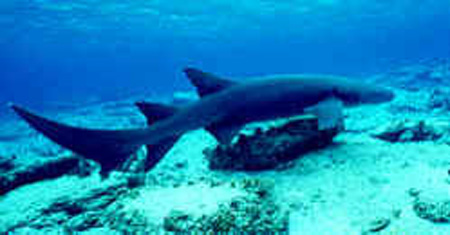|
|

|

What To Look For:
A large brownish shark; mouth well in front of eyes; first dorsal fin
base over pelvic fin base. This shark is also known as Tawny Nurse Shark,
Giant Sleepy Shark or Spitting Shark.
Color:
Tan to dark greyish brown according to habitat.
Size:
Males are mature by 8.2 ft (2.5m), females by 7.5 ft (2.3)m. Maximum
total length is 10.3 to 10.5 ft (3.14 to 3.20m), but most individuals
are smaller.
Teeth:
Small, cusped teeth.
Habitat:
Tropical inshore shark of the continental and insular shelves, common
in intertidal waters and from the surf zone to 230 ft (70m). Usually
found on or near the bottom in lagoons, off sandy beaches, sandy areas
near reefs or along the outer edges of coral reefs. The shark seems to
prefer sheltered areas in crevices and caves on reefs, but it is often
found in more exposed areas in a depression or crevice.
Distribution:
lndo-West and Central Pacific: Australia (Queensland), Tahiti, Marshall
Islands, Palau, Samoa, New Ireland, New Caledonia, Papua New Guinea,
China, Vietnam, Thailand, Singapore, Indonesia, Malaysia, India,
Seychelles and Madagascar to Red Sea, Mauritius and South Africa.
Biology:
• Prey:
Corals, crabs, lobsters and other crustaceans, octopus, squid and
probably other cephalopods, sea urchins and reef fish, including
surgeonfishes and siganids.
• Reproduction:
Sources are conflicting: According to Grant (1982) the shark is an
egg-layer, an oviparous shark that produces pale yellow, onion-shaped
eggs 3.5 inches (90 cm). According to Compagno (1984) the shark is
ovoviviparous; egg cases are retained in utero until the young hatch and
are born alive. The shark produces at least 4 pups per uterus and size of
each at birth is about 15.7 inches (40 cm).
Behaviour:
• Feeding:
When foraging, the shark moves along the bottom and explores depressions,
holes and crevices in the reef. When potential prey is located the shark
places its small mouth very close to its intended victim and uses its
large pharynx as a powerful suction to rapidly inhale the organism. When
caught by fisherman the shark may throw the sucking apparatus in reverse;
it will blast streams of water out of its mouth and into the face of its
captor. The shark is reported to make a vulgar grunting sound between
streams.
Disposition:
The tawny nurse shark is primarily nocturnal, resting in daytime shelters
and slowly prowling the reefs at night, although a few individuals may be
active by day. The shark is gregarious and forms resting aggregations of 2
to 6 or more sharks in shelters; they are often seen piled across or atop
one another when resting, the shark is very sluggish.
• Danger To Humans:
Said to be more docile than the nurse shark, and often allows divers to
handle it, but it is credited with a few provoked attacks In these cases
the sharks have bitten their tormentors, and clamped tightly onto to them.
|

Back To Top
|
|